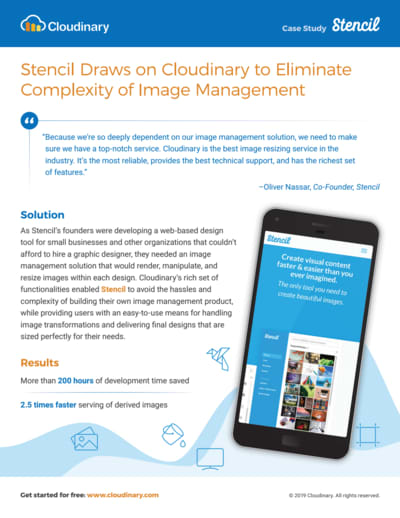Stencil is an online graphic-design platform on which you can efficiently create images for social media, blogs, presentations, and such. A viable alternative to a more robust software like Photoshop, Stencil enables novices to design like a pro.
While developing a design tool years ago, Stencil needed an image-management solution for rendering, manipulating, and resizing images. Cloudinary surfaced as a viable option in September 2013 and Stencil soon set about integrating it as a core platform component. Cloudinary’s robust capabilities proved to be ideal, saving Stencil the hassle of building its own tool and according its users an intuitive means for transforming and crafting perfectly-sized images.
After adopting Cloudinary, Stencil reaped many remarkable benefits, including, but not limited too:
- A saving of over 200 hours development time
- A higher serving speed of two-and-a-half times for finalized images
Stencil cofounders Oliver Nassar and Adam Rotman determined early on that building an image-management and transformation solution for their platform was not practicable. Why? “I’d done that before and knew the kinds of problems you could run into,” explained Nassar, citing storage costs, memory issues, and the expertise and time required for managing server farms.
The Stencil media library, hosted on Amazon S3, is the repository for the platform’s original images, which are then uploaded to Cloudinary for processing. As a start, Cloudinary generates thumbnails for all the images, after which Stencil users can manipulate those images within their own designs with Cloudinary’s unique URL-based API.
Cloudinary’s useful features have been a boon for Stencil’s development roadmap. Recently, Stencil added custom options for a cropping system for creating shapes by leveraging Cloudinary’s mask and cutter features, saving time and effort appreciably.
Nassar pointed out that Cloudinary plays a key role in Stencil’s delivery of finished designs, either as previews or for downloads to users’ computers. That process starts with a Preview & Share option, which generates image links created by Cloudinary for display on social media or dispatch to smartphones. Once the users have specified the size and dimensions they desire, Stencil resizes the designs with Cloudinary before final handoff.
Currently, Stencil hosts over 500,000 images and supports more than 1.5 million transformations a month. It’s no wonder that effective and efficient image management ranks at the top of Stencil’s business needs, let alone that it’s a key factor that ensures a rich user experience.
In addition, Stencil values Cloudinary’s reliability, high availability, and uptime. “We’ve had fewer problems with Cloudinary than other services we use,” said Nassar, adding that his team can always count on prompt responses from Cloudinary’s support team in case of questions.
Nassar emphasized that he’s never found any reason to move from Cloudinary, which he considers the best image-management service around with the most dependable technical support. “Even though we only use a few Cloudinary features, they satisfy all our needs,” he concluded.

